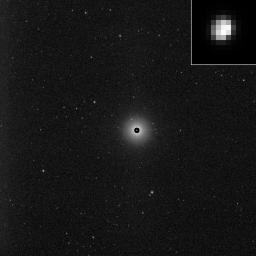This image, processed to show the true size of the giant asteroid Vesta, shows Vesta in front of a spectacular background of stars. It was obtained by the framing camera aboard NASA's Dawn spacecraft on May 3, 2011, from a distance of about 1.2 million kilometers (750,000 miles). Since Vesta is so bright that it outshines its starry background, Dawn team members commanded a long exposure time to make the stars visible. They corrected the resulting exaggerated size of Vesta by superimposing a short exposure image of the target asteroid, showing its true size. Vesta is the small, bright pearl in the middle of the image.
Vesta is 330 miles (530 kilometers) in diameter and the second most massive object in the asteroid belt. But, as the inset shows, Vesta is approximately five pixels across in size in Dawn's early approach images.
This and other images will help Dawn fine tune navigation during its approach to Vesta, with arrival expected on July 16, 2011.
The Dawn mission to Vesta and Ceres is managed by the Jet Propulsion Laboratory, for NASA's Science Mission Directorate, Washington, D.C. It is a project of the Discovery Program managed by NASA's Marshall Space Flight Center, Huntsville, Ala. UCLA is responsible for overall Dawn mission science. Orbital Sciences Corporation of Dulles, Va., designed and built the Dawn spacecraft.
The framing cameras have been developed and built under the leadership of the Max Planck Institute for Solar System Research, Katlenburg-Lindau, Germany, with significant contributions by the German Aerospace Center (DLR) Institute of Planetary Research, Berlin, and in coordination with the Institute of Computer and Communication Network Engineering, Braunschweig. The framing camera project is funded by the Max Planck Society, DLR, and NASA.
JPL is a division of the California Institute of Technology, in Pasadena.
More information about Dawn is online at http://www.nasa.gov/dawn and http://dawn.jpl.nasa.gov.

 Planetary Data System
Planetary Data System












